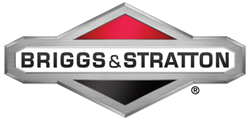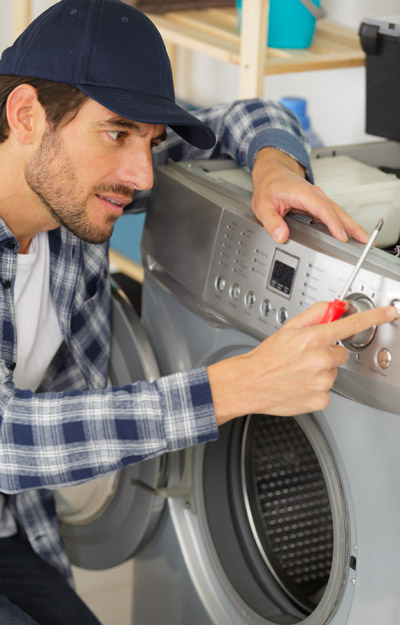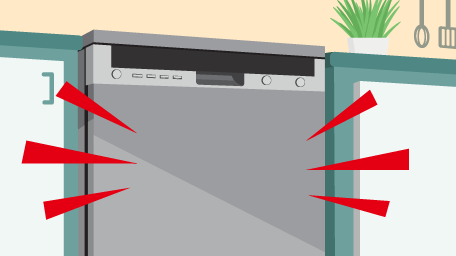Enter the code USA15 at checkout to apply your discount. Discount will be applied at checkout when the code is entered & applies to all parts. Cannot be combined with any other coupon or special offer & cannot be applied to a previously placed order. Not valid toward tax or shipping & handling. Discount has no cash value. Discount expires on July 1 at 11:59pm EST.

Why Your Dishwasher is Stopping Mid-Cycle
A dishwasher stopping mid-cycle can happen for various reasons, often linked to a specific part or problem that will need to be resolved for it to run properly. Signs of a specific issue may include blinking lights, or starting and then stopping abruptly when filling. It's normal for dishwashers to pause mid-cycle to drain or heat water up, but there's a distinct difference between pausing and shutting off completely. Resetting your dishwasher or manually activating the drain can resolve it stopping mid-cycle, but the underlying cause must still be fixed, which means inspecting and testing a number of parts. Whether it's a simple fix like a clogged drain filter or a more complex issue like a malfunctioning door latch assembly or control board, this article will guide you through the required supplies, and instructions for diagnosing and fixing your dishwasher if it's stopping in the middle of a cycle.
General Problems that Cause a Dishwasher to Stop Mid-Cycle
It can be frustrating when your dishwasher stops mid-cycle, but understanding some general problems that can cause it will help you fix it quicker. We'll explore a few common issues, like a clogged filter and drain hose, low water pressure, and power failures, to help you resolve this stopping problem quickly and easily.
Clogged Filter and Drain Hose
A dishwasher's filter and hose, which are parts of the draining system, are used to trap food particles and debris from harming valuable parts like the pump, and remove dirty water from the dishwasher. If either of these parts is clogged, blocked, or damaged, the dishwasher will stop to avoid any overflow or potential damage to your home or its parts. If you see a series of lights or an error code appear when this occurs, note it and refer to your user manual for further information on the issue.
- Unplug your dishwasher and turn off its water supply.
- Open the dishwasher door and remove its filter. This may require a screwdriver or pliers to remove.
- Inspect the inside of the filter and its housing for any clogs caused by gunk or debris, and use a brush or sponge, and warm soapy water to clean the filter. If the filter is damaged, replace it immediately.
- Once the filter and its housing are cleaned, locate the dishwasher's drain hose underneath the sink, and inspect the drain hose for any clogs or foreign objects lodged inside.
- Place a large bowl or bucket underneath the drain hose opening and disconnect it from the sink drain. Lift the hose and water should rush into the bucket if there's any left. Then use a drain brush to clean it, or replace it if necessary.
- Reassemble the drain hose and filter assembly, start a cycle, and monitor it for any more stoppages.
Low Water Pressure
The pressure of the water being supplied to the dishwasher is important, because if it's too weak it will cause extended filling times and poor cleaning performance. This is why many dishwashers feature sensors that can accurately detect issues with it, and will stop your dishwasher mid-cycle if not enough water is being supplied.
- Locate the water supply valves in your home, and inspect its gauge. The reading should be between 14.5 to 80 psi, and a rating over 116 psi would be too high.
- If your water supply doesn't have a gauge, shut the valves closed.
- Unplug your dishwasher.
- Use a screwdriver to unthread the kick plate at the bottom of your dishwasher, and disconnect one of the fill hoses. Expect some water to spill out.
- Put the fill hose into a bowl or large bucket and turn the corresponding water supply valve until it's open.
- If the water strength going into the bowl or bucket is weak, you have an issue with your home's water supply. If the water flow is strong, continue reading this guide.
Power Failure
Dishwashers can stop suddenly during a cycle due to power problems, either with your home or the appliance itself. Check your circuit breaker for burn marks, and the dishwasher's power cord for damage like breaks or exposed wires. If necessary, contact an electrician to properly inspect and fix your home's circuit breaker or dishwasher's power cord.
What Parts You Need to Replace to Fix a Dishwasher That Stops Mid-Cycle
When your dishwasher abruptly stops mid-cycle, it's often due to issues with key parts like the door latch, float switch, heating element and fuse, inlet valves, drain pump, and electronic control board. We'll walk you through how to inspect, test, and replace each of these parts, so you can effectively resolve the mid-cycle stopping problem with your dishwasher.
How to Replace a Door Latch to Fix a Dishwasher That Stops Mid-Cycle
The door latch assembly is the most common culprit for dishwashers that stop mid-cycle because the door switch, handle, and latch mechanisms ensure the safe and proper operation of the dishwasher. When these parts break or stop working properly, they can cause the dishwasher to stop mid-cycle due to safety triggers that interpret the door as being open. Unless there's a specific code or indication otherwise, a bad door latch assembly in some models is indicated by the dishwasher stopping mid-cycle and blinking its lights. If your door latch assembly is broken or not working, you may also notice it's easy to open, and tough to close fully.
Supplies You'll Need
- Philips-head and Flat-head Screwdriver
- Socket Wrench
- Needle-Nose Pliers
- Multimeter
Step-by-Step Guide:
- Shut off the water supply to your dishwasher.
- Use a screwdriver to remove the kickplate at the bottom of your dishwasher.
- Unthread any screws securing your dishwasher below a countertop if necessary, then pull your dishwasher out and unplug it from its wall outlet.
- Locate the door catch on the upper portion of the dishwasher tub. If it's damaged, replace it by unthreading it and disconnecting its wire harness, and securing the new one.
- If the door catch isn't broken, the door switch or latch may be. Start by using a screwdriver to unthread the screws around the dishwasher door's inside perimeter.
- You should now be able to lift and separate the two halves and grab the door switch inside.
- Remove the wire harnesses from the door switch. If you notice any damage to the latch, like cracks or pieces chipped off, replace it immediately.
- Locate the door switch on the assembly, and remove it. Then with a multimeter set to ohms, touch each probe to a terminal on the switch. if you don't hear a beep, the switch does not have continuity and will need replacing.
- Install the switch into the housing, connect its wire harnesses, and install it within the door assembly.
- Thread the screws back into the door.
- Begin to carefully close the door, and monitor your dishwasher to see if the stopping issue is resolved.
How to Clean or Replace a Float Switch to Fix a Dishwasher That Stops Mid-Cycle
The float switch in your dishwasher is a safety device that detects water levels to prevent overflowing. Over time it can get covered in gunk or stuck, and may not be operable and able to accurately sense the level of water, causing the mid-cycle stops. We'll explain how to clean and test your dishwasher's float switch with a multimeter and replace it if needed, to get your dishwasher working again, without stoppages.
Supplies You'll Need
- Philips-head and Flat-head Screwdriver
- Socket Wrench
- Needle-Nose Pliers
- Multimeter
- Brush or Sponge
- Drain Brush
- Soap and Warm Water
- Towels
Step-by-Step Guide:
- First, shut off the water supply to your dishwasher.
- Use a screwdriver to unthread and remove the kickplate at the bottom of your dishwasher.
- Disconnect the fill hose from the inlet valve. This may require pliers and towels.
- Unthread any securing screws holding your dishwasher under your counter, pull it out, and unplug your dishwasher from the wall outlet.
- Open the dishwasher door and remove the lower dish rack, and locate the top of the float switch.
- The switch may only be stuck, which can be fixed by moving it up and down. If it's not stuck or if you'd like to test it, remove the stem of the float switch (looks like a mushroom-top), then use a wrench to loosen any securing nuts.
- Tilt the dishwasher onto its back, so you can access underneath it.
- Locate the float switch housing and remove the wire harnesses connected to the float switch to remove it.
- If your float switch is covered in food debris or grime, clean it off with a towel and reinstall it to see if the stopping issue is resolved. Or follow the next steps to test it for continuity.
- With a multimeter set to continuity, depress the switch and touch the two probes to the terminals on the switch. If you hear a beep, the switch is good. Release the switch and test it again; if there's a beep, the switch is bad and will need replacing.
- Install the switch back into its housing and connect its wire harnesses.
- Tilt the dishwasher back and reinstall the stem of the switch.
- Replace the dish rack and resecure your dishwasher underneath your counter, connect the fill hose, and plug the dishwasher back in.
- Turn the water supply back on before running a test cycle and seeing if that resolves your issue.
How to Replace a Heating Element to Fix a Dishwasher That Stops Mid-Cycle
Heating elements raise the water temperature for effective dish cleaning and drying, but when a heating element fails, it may also lead to a blown fuse, disrupting the power supply and causing the dishwasher to stop abruptly. We'll help you diagnose and potentially replace a faulty heating element and blown fuse, to fix your dishwasher's mid-cycle stopping.
Supplies You'll Need
- Philips-head and Flat-head Screwdriver
- Socket Wrench
- Needle-Nose Pliers
- Multimeter
Step-by-Step Guide:
- Open your dishwasher door and visually inspect the heating element at the bottom of the dishwasher. If it has visible damage, like burns or breaks, it will need to be replaced.
- Shut off the water valves to your dishwasher.
- Unthread and remove the kickplate.
- Disconnect the fill and drain hoses.
- Unthread any mounting screws keeping your dishwasher under your counter. Then pull it out, and unplug it from the wall outlet.
- Tilt the dishwasher on its back just enough so you can access the heating element and fuse. The element will likely be at the rear and the fuse at the front.
- Unplug the wire harnesses connected to the heating element and fuse, then remove them carefully.
- Test the heating element using a multimeter in continuity mode, by touching each terminal with a probe. If there's no continuity in the heating element or fuse, replace one or both.
- Install the heating element and fuse back into their respective housings in the dishwasher, and connect their wire harnesses.
- Tilt the dishwasher back, slide it back into place, plug it in, and thread its mounting screws.
- Connect its fill and drain hoses, and turn the water valves back on.
- Start a cycle and monitor your dishwasher to see if the issue returns.
How to Replace an Inlet Valve to Fix a Dishwasher That Stops Mid-Cycle
The inlet valves electronically control the flow of water into your dishwasher during each cycle. When these valves fail, the dishwasher may not receive enough water, resulting in mid-cycle stops. If your dishwasher's inlet valves fail, you might notice water leaking from the bottom while it's running. We'll walk you through a step-by-step process to inspect, troubleshoot, and potentially replace the inlet valves, to get your dishwasher working without interruption.
Supplies You'll Need
- Philips-head and Flat-head Screwdriver
- Socket Wrench
- Needle-Nose Pliers
- Multimeter
- Towels
Step-by-Step Guide:
- Shut off the water supply to your dishwasher.
- Unplug your dishwasher from the wall outlet. If that's not possible, turn off the outlet at the breaker.
- Unthread and remove the dishwasher's kick plate.
- Locate the inlet valve underneath the dishwasher; it will normally appear as a blue, white, or clear plastic pipe with a wire and bracket attachment.
- Remove the wires from it, then place towels down before you disconnect the fill hose as well.
- Inspect the inlet valves, and if no damage is present, use a multimeter to test its continuity.
- With the multimeter in continuity mode, touch each probe to a terminal on the inlet valve. If the reading is between 500 to 1500 ohms, the valve has continuity. However, if there's no reading, it's weak, or if they're damaged, replace the inlet valves.
- Install the inlet valve by securing it within the dishwasher bracket and installing its wires and fill hose.
- Reinstall the kick plate and connect your dishwasher back to power.
- Begin a cycle and monitor your dishwasher to see if it stops mid-cycle again.
How to Replace a Pump to Fix a Dishwasher That Stops Mid-Cycle
A clogged or malfunctioning dishwasher pump, whether due to mechanical or electrical failure, can cause your dishwasher to stop suddenly during a cycle. However, severe clogs caused by gunk or foreign objects can also lead to this issue. If your dishwasher's pump is clogged, a common sign you may notice is water left at the bottom after a cycle. If this is the case, cleaning or replacing the pump is necessary to get your dishwasher washing properly again.
Supplies You'll Need
- Philips-head and Flat-head Screwdriver
- Socket Wrench
- Needle-Nose Pliers
- Multimeter
- Bucket or Large Bowl
- Brush or Sponge
- Drain Brush
- Soap and Warm Water
- Towels
Step-by-Step Guide:
- Shut off the dishwasher's water supply.
- Turn off the dishwasher's power by unplugging it or turning off its breaker.
- Unthread the dishwasher's kick plate and remove it.
- Unthread the fill hose from the inlet valve, and disconnect the drain hose from your sink or garbage disposal.
- Unthread the dishwasher mounting screws under the countertop.
- Carefully pull the dishwasher out and tilt it on its back to access the pumps.
- Locate the pump under your dishwasher, and disconnect any wire connectors or hoses connected to it. Your dishwasher may have multiple pumps, which should all be inspected and cleaned, if necessary.
- Remove the pump and inspect it for any clogs by gunk or foreign objects.
- If it's not clogged, use a multimeter set to continuity mode, to test the pump for continuity. The pump's terminals should give a reading between 15-40 ohms, and if they give a weak reading, the pump has failed and will need to be replaced.
- Install the pump, and the necessary wire connectors and hoses.
- Push the dishwasher back into place, then thread the fill hose to the inlet valve, and install the drain hose underneath your sink.
- Replace the kick plate, plug in your dishwasher, and turn the water supply on. Run a cycle and see if the dishwasher stops mid-cycle.
How to Replace an Electronic Control Board to Fix a Dishwasher That Stops Mid-Cycle
As the brains of your dishwasher, the electronic control board oversees its various functions. As a result, a malfunctioning control board could be to blame for mid-cycle shutdowns or other system issues, like a short causing it to be unable to properly regulate functions like filling and draining. When this happens, it's important to replace your dishwasher's electronic control board, so it can resume smooth dishwashing without interruption.
Supplies You'll Need
- Philips-head and Flat-head Screwdriver
- Socket Wrench
- Needle-Nose Pliers
- Multimeter
Step-by-Step Guide:
- Make sure the circuit breaker and water supply to your dishwasher are turned off.
- Check your owner's manual for the exact location of the electronic control board. Some may be located underneath the appliance, behind the kick plate, whereas others may be located within the door panel, near the control panel.
- If your model's control board is below the appliance, use a screwdriver to unthread and remove the kickplate to access it. If yours is in the door, unthread the screws around the perimeter of the door's inside frame and separate the two halves.
- Once you have access to the control board, take note of the wire connectors attached to the control board, and disconnect them.
- Take the new electronic control board and plug in the necessary wire connectors to install it.
- Reassemble your dishwasher door or kick plate, turn the circuit breaker back on, and run a test cycle to ensure the dishwasher works again.
Now that your dishwasher is running again without interruption, you can get back to the convenience of clean dishes without having to hand-wash them! If you're looking for more helpful and convenient articles like this one, take a swing over to our appliance error code and how-to guides, as well as our home improvement articles at the PartSelect.com blog!






























